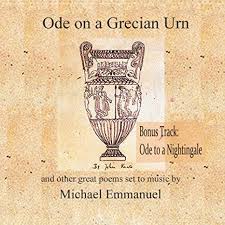
An ode is a lyric poem that is written to praise a person, event, or object. It is an elaborately structured form of poetry and was popular during the 19th century. Because of the complex structure of the poem, it is not as common among the modern poets. Many of the classic Odes have been put to music by such greats as Purcell, Boyce and Handel.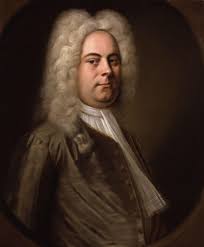
You may have heard or read the famous “Ode on a Grecian Urn” by John Keats. (Some students mistakenly believe that this poem was written on the physical urn, when in fact the poem is written about an urn — it is an ode to the urn.) John Keats was a House Surgeon at Guy’s Hospital in London when the poetic bug caught him and he left the job to concentrate on writing poems. He wrote many Odes and the famous Ode on a Grecian Urn was published in 1819. I must admit that this was the poem that caught my interest in poetry. It is complex at the same time sweet and soothing.
Ode on a Grecian Urn
‘Thou still unravish’d bride of quietness!
Thou foster-child of silence and slow time
Sylvan historian, who canst thus express
A flow’ry tale more sweetly than our rhyme:
What leaf-fring’d legend haunts about thy shape
Of deities or mortals, or of both,
In Tempe or the dales of Arcady?
What men or gods are these? What maidens loth?
What mad pursuit? What struggle to escape?
What pipes and timbrels? What wild ecstasy?
Heard melodies are sweet, but those unheard
Are sweeter; therefore, ye soft pipes, play on;
Not to the sensual ear, but, more endear’d,
Pipe to the spirit ditties of no tone:
Bold Lover, never, never canst thou kiss,
Though winning near the goal – yet, do not grieve;
She cannot fade, though thou hast not thy bliss,
For ever wilt thou love, and she be fair!
For ever panting, and for ever young;
All breathing human passion far above,
That leaves a heart high-sorrowful and cloyed,
A burning forehead, and a parching tongue.
Who are these coming to the sacrifice?
To what green altar, O mysterious priest,
Lead’st thou that heifer lowing at the skies,
And all her silken flanks with garlands drest?
What little town by river or sea shore,
Or mountain-built with peaceful citadel,
Is emptied of its folk, this pious morn?
And, little town, thy streets for evermore
Will silent be; and not a soul to tell
Why thou art desolate, can e’er return.
O Attic shape! Fair attitude! with brede
Of marble men and maidens overwrought,
With forest branches and the trodden weed;
Thou, silent form, dost tease us out of thought
As doth eternity: Cold pastoral!
When old age shall this generation waste,
Thou shalt remain, in midst of other woe
Than ours, a friend to man, to whom thou sayst,
“Beauty is truth, truth beauty,” – that is all
Ye know on earth, and all ye need to know.’
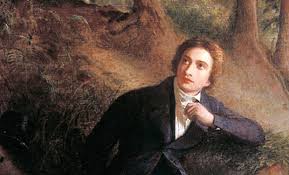 John Keats
John Keats
The ode is a classical style of poetry, once used by the ancient Greeks and Romans, who sang their odes rather than writing them on paper. Today’s odes are usually rhyming poems with irregular meter. They are broken into stanzas (the “paragraphs” of poetry) with ten lines each, sometimes following a rhyming pattern, although rhyme is not required for a poem to be classified as an ode. Usually, odes have three to five stanzas.
There are three types of odes: 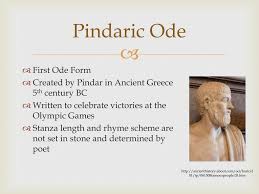 pindaric, horatian, and irregular. Pindaric odes have three stanzas, two of which have the same structure. An example is ”The progress of poesy” by Thomas Gray.
pindaric, horatian, and irregular. Pindaric odes have three stanzas, two of which have the same structure. An example is ”The progress of poesy” by Thomas Gray.
Horatian odes have more than one stanza, all of which follow the same rhyme structure and meter. An example is @Ode to the Confederate dead” by Allen Tate.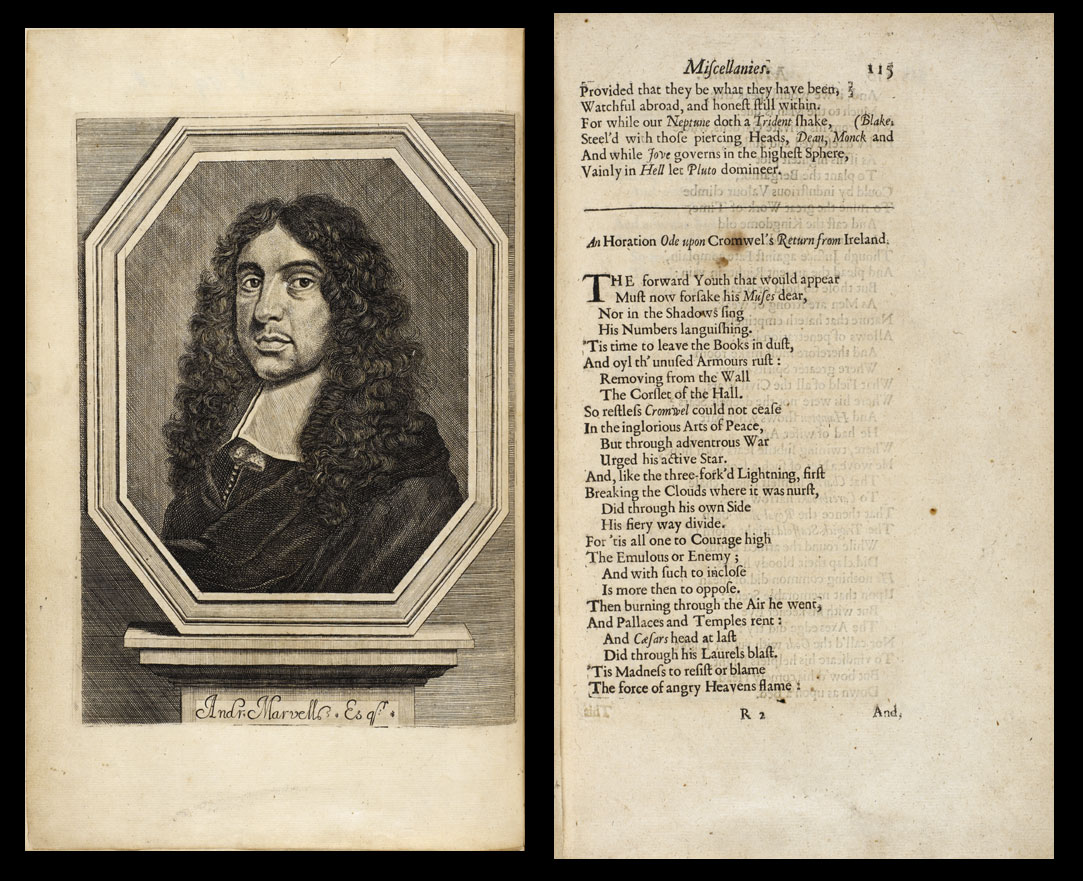
Irregular odes follow no set pattern or rhyme. An example is “Ode to an Earthquake” by Ram Mehta. Read a few examples of odes to get a feeling for what they are like before you write your own.
Horatian odes use rhyming structure which can be best explained by examining John Keats’ Ode to a Nightingale where the rhyming structure is quite simple and easy to use – ABABCDECDE. It is a ten-line stanza and usually has five or six stanzas. But Shelley on the other hand used only five lines in his stanzas with an ABABB rhyming structure – Ode to a Skylark. Pindaric Odes are more complex using a rotating structure of strophe-antistrophe-epode.
Here are my examples. I have used the simple Horatian structure with ten-line stanzas, but with irregular rhyming pattern inline with most modern poets.
Everyone cherishes memories if they are sweet and happy. Memories of some events, the first glimpse of the lover, first time hands are held or the first kiss carry such a powerful imprint that it is almost impossible to erase.
Ode to Memories

This heart filled with hundred memories
Fond memories of first sight and first touch
The electric feeling at the first smile
Holding hands for the first time
The first kiss, tender and hesitant
Are they just memories of a dream?
Dream eons ago in a different life maybe
But they seem like only yesterday
Yet they feel so fresh, so real
It is so distant it could be a mirage.
Hundred memories of days gone by
Not real, not in essence and not of this world
My heart skips a beat even now
At the memory of our first embrace, heavenly
I can hear the sounds of the waves
The birds chirping as we sat on the shore
As the sun set on the horizon
With crimson blood and bright orange glow
As the water lapped on our feet
I am transposed a thousand miles from the shore.
A thousand memories of the day by gone
Walked through the glade with blue bells
And poppies, bright red dotted around
A little stream gurgling past us
A Deer and its calf drinking at the stream
Gentle breeze waving the green branches
Laden low with weight of the bounty
Of flowers, fruits and birds galore
Two love birds watching us, jealous
As we cuddled and kissed under the oak tree.
A million memories of the day
We sat under the oak tree
Whispering sweet nothings to each other
The day we swore our love for each other
I still remember your cheeks blush
When I said I love you
With a passion so gentle and soft
You squeezed my hands and hugged me close
I didn’t want the moment to pass
As I cherished the feeling of belonging.
The day of memories flushed with love
A feeling of fulfilment and immeasurable joy
A day of immense happiness no one can deny
I was on top of this world
Not willing to come down for anyone
Heady with a feeling of accomplishment, of love
The tint in my eye was not a blemish
It made the world look rosy all the time
My head was swollen, not with pride
But with an overflowing sensation of love.
I remember the day we sat on top of the mountain
Savouring the vista of rolling hills in the distance
A river meandering through the lush forest floor
The cloudless sky watched us, blue with envy
It did miss its love, the curvy clouds
Even the birds seem to know
That we are a pair deep in love
They swooped in to take a closer look
Only to fly away with a heaving chest
And a flurry of wings at their best.
The days and years have passed my love
But my love hasn’t diminished
My heart still skips a beat when I see you
The mind is raging with hope
A hope to stay together, till the end of days
It is still like the first day, as fresh as
The daisies in the garden at the first sign of spring
Or those yellow Daffodils heralding the spring
Till death do us part is only for this world
Our love will live forever in every world.
Shankar Kashyap

Very informative and beautiful
LikeLiked by 1 person
Thank you
LikeLike
Beautiful.
LikeLiked by 1 person
Thank you
LikeLiked by 1 person